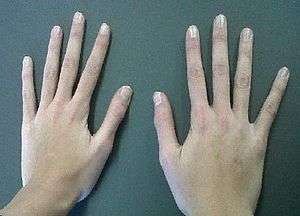Arachnodactyly
| Arachnodactyly | |
|---|---|
|
Arachnodactyly | |
| Classification and external resources | |
| Specialty | medical genetics |
| ICD-10 | Q87.4 (ILDS Q87.410) |
| ICD-9-CM | 759.82 |
| DiseasesDB | 15196 |
| MedlinePlus | 003288 |
| MeSH | D008382 |
Arachnodactyly ("spider fingers") or achromachia is a condition in which the fingers and toes are abnormally long and slender, in comparison to the palm of the hand and arch of the foot. Also, the individual's thumbs tend to also be pulled inwards towards the palm.[1] It can be present at birth or develop in later life.
Causes
This feature can occur on its own, with no underlying health problems. However, it can also be associated with certain medical conditions. Examples include Marfan syndrome,[2] Ehlers-Danlos syndrome,[3] Loeys–Dietz syndrome, Congenital contractural arachnodactyly,[1] and homocystinuria.
Arachnodactyly has been linked to mutations in both fibrillin-1 and fibrillin-2 genes.
Notable cases
It remains unconfirmed whether composer Sergei Rachmaninoff's abnormally large reach on a piano was a result of arachnodactyly due to Marfan syndrome, as the pianist exhibited no other signs of the disease.[4]
See also
References
- 1 2 Viljoen, D. (1994). "Congenital contractural arachnodactyly (Beals syndrome)" (PDF). Journal of Medical Genetics. 31 (8): 640–643. doi:10.1136/jmg.31.8.640. PMC 1050028
 . Retrieved 25 September 2015.
. Retrieved 25 September 2015. - ↑ Buntinx, I. M.; Willems, P. J.; Spitaels, S. E.; Van Reempst, P. J.; De Paepe, A. M.; Dumon, J. E. (April 1991). "Neonatal Marfan syndrome with congenital arachnodactyly, flexion contractures, and severe cardiac valve insufficiency". Journal of Medical Genetics. 28 (4): 267–273. doi:10.1136/jmg.28.4.267. ISSN 0022-2593. PMC 1016831
 . PMID 1856834.
. PMID 1856834. - ↑ Keer, Rosemary; Grahame, Rodney (2003-06-27). "Hypermobility syndrome: Recognition and management for physiotherapists". ISBN 978-0-7506-5390-9.
- ↑ http://www.rachmaninoff.org/board/viewtopic.php?f=5&t=480
| Wikimedia Commons has media related to Arachnodactyly. |
